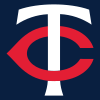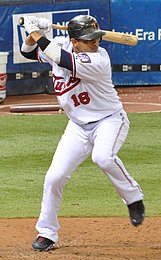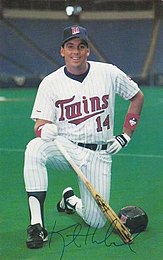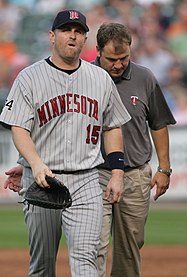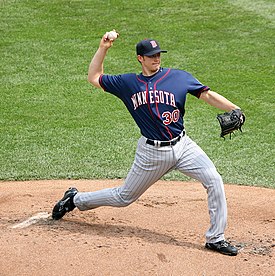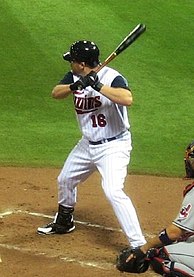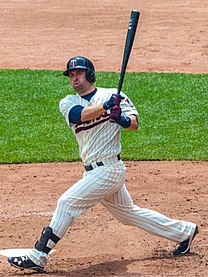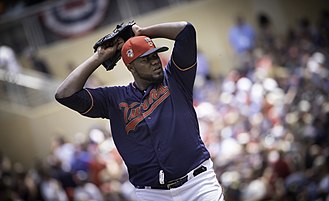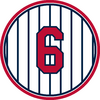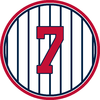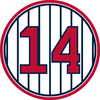Minnesota Twins
| Minnesota Twins | |||||
|---|---|---|---|---|---|
| |||||
| Major league affiliations | |||||
| |||||
| Current uniform | |||||
 | |||||
| Retired numbers | |||||
| Colors | |||||
| Name | |||||
| Other nicknames | |||||
| |||||
| Ballpark | |||||
| |||||
| Major league titles | |||||
| World Series titles (3) | |||||
| AL Pennants (6) | |||||
| AL West Division titles (4) | |||||
| AL Central Division titles (9) | |||||
| Wild card berths (1) | 2017 | ||||
| Front office | |||||
| Principal owner(s) | Pohlad family (Joe Pohlad, chairman)[4] | ||||
| President of baseball operations | Derek Falvey (Chief Baseball Officer)[6][7] | ||||
| General manager | Vacant | ||||
| Manager | Rocco Baldelli[5] | ||||
| Mascot(s) | Twinkie (1980–1981) T.C. Bear (2000–present) | ||||
| Website | mlb.com/twins | ||||
The Minnesota Twins are an American professional baseball team based in Minneapolis. The Twins compete in Major League Baseball (MLB) as a member club of the American League (AL) Central Division. The team is named after the Twin Cities moniker for the two adjacent cities of Minneapolis and Saint Paul.[8]
The franchise was founded in Washington, D.C., in 1901 as the Washington Senators. The team moved to Minnesota and was renamed the Minnesota Twins for the start of the 1961 season. The Twins played in Metropolitan Stadium from 1961 to 1981 and in the Hubert H. Humphrey Metrodome from 1982 to 2009. The team has played at Target Field since 2010.[9]
The franchise won the World Series in 1924 as the Senators,[10] and in 1987 and 1991 as the Twins. From 1901 to 2023, the Senators/Twins franchise's overall regular-season win–loss–tie record is 9,259–9,955–109 (.482); as the Twins (through 2024), it is 5,036–5,091–8 (.497).[11]
History
[edit]Washington Nationals/Senators: 1901–1960
[edit]
The team was founded in Washington, D.C., in 1901 as one of the eight original teams of the American League. It was named the Washington Senators from 1901 to 1904, the Washington Nationals from 1905 to 1955, and the Senators again from 1956 to 1960. But the team was commonly referred to as the Senators throughout its history (and unofficially as the "Grifs" during Clark Griffith's tenure as manager from 1912 to 1920).[12] The name "Nationals" appeared on uniforms for only two seasons, and then was replaced with the "W" logo. The media often shortened the nickname to "Nats" — even for the 1961 expansion team. The names "Nationals" and "Nats" were revived in 2005, when the Montreal Expos moved to Washington to become the Nationals.
The Washington Senators spent the first decade of their existence finishing near the bottom of the American League standings. The team's long bouts of mediocrity were immortalized in the 1955 Broadway musical Damn Yankees.[13] Their fortunes began to improve with the arrival of 19-year-old pitcher, Walter Johnson, in 1907. Johnson blossomed in 1911 with 25 victories, although the team still finished the season in seventh place.[14] In 1912, the Senators improved dramatically, as their pitching staff led the league in team earned run average and in strikeouts. Johnson won 33 games while teammate Bob Groom added another 24 wins to help the Senators finish the season in second place.[15] Griffith joined the team in 1912 and became the team's owner in 1920.[16] (The franchise remained under Griffith family ownership until 1984.[17]) The Senators continued to perform respectably in 1913 with Johnson posting a career-high 35 victories, as the team once again finished in second place.[18] The Senators then fell into another decline for the next decade.

The team had a period of prolonged success in the 1920s and 1930s, led by Walter Johnson, as well as fellow Hall-of-Famers Bucky Harris, Goose Goslin, Sam Rice, Heinie Manush, and Joe Cronin.[19] In particular, a rejuvenated Johnson rebounded in 1924 to win 23 games with the help of his catcher, Muddy Ruel, as the Senators won the American League pennant for the first time in its history.[20] The Senators then faced John McGraw's heavily favored New York Giants in the 1924 World Series.[21] The two teams traded wins back and forth with three games of the first six being decided by one run.[22][23] In the deciding 7th game, the Senators were trailing the Giants 3–1 in the 8th inning when Bucky Harris hit a routine ground ball to third that hit a pebble and took a bad hop over Giants third baseman Freddie Lindstrom. Two runners scored on the play, tying the score at three.[24] An aging Walter Johnson came in to pitch the ninth inning and held the Giants scoreless into extra innings. In the bottom of the twelfth inning, Ruel hit a high, foul ball directly over home plate.[25] The Giants' catcher, Hank Gowdy, dropped his protective mask to field the ball but, failing to toss the mask aside, stumbled over it and dropped the ball, thus giving Ruel another chance to bat.[25] On the next pitch, Ruel hit a double; he proceeded to score the winning run when Earl McNeely hit a ground ball that took another bad hop over Lindstrom's head.[24][25] This would mark the only World Series triumph for the franchise during their 60-year tenure in Washington.
The following season they repeated as American League champions but ultimately lost the 1925 World Series to the Pittsburgh Pirates. After Walter Johnson retired in 1927, he was hired as manager of the Senators. After enduring a few losing seasons, the team returned to contention in 1930. In 1933, Senators owner Griffith returned to the formula that worked for him nine years earlier: 26-year-old shortstop Joe Cronin became player-manager. The Senators posted a 99–53 record and cruised to the pennant seven games ahead of the New York Yankees, but in the 1933 World Series the Giants exacted their revenge, winning in five games. Following the loss, the Senators sank all the way to seventh place in 1934 and attendance began to fall. Despite the return of Harris as manager from 1935 to 1942 and again from 1950 to 1954, Washington was mostly a losing ball club for the next 25 years contending for the pennant only during World War II. Washington came to be known as "first in war, first in peace, and last in the American League";[26] their hard luck drove the plot of the musical and film Damn Yankees. Cecil Travis, Buddy Myer (1935 A.L. batting champion), Roy Sievers, Mickey Vernon (batting champion in 1946 and 1953), and Eddie Yost were notable Senators players whose careers were spent in obscurity on losing teams.[27][28] In 1954, the Senators signed future Hall of Fame member Harmon Killebrew. By 1959, he was the Senators' regular third baseman and led the league with 42 home runs, earning him a starting spot on the American League All-Star team.
After Griffith's death in 1955, his nephew and adopted son Calvin took over the team presidency. Calvin sold Griffith Stadium to the city of Washington and leased it back. This led to speculation that the team was planning to move, as the Boston Braves, St. Louis Browns, and Philadelphia Athletics had done in recent years. By 1957, after an early flirtation with San Francisco (where the New York Giants would move after the season), Griffith began courting Minneapolis–St. Paul, a prolonged process that resulted in his rejecting the Twin Cities' first offer[29] before agreeing to move. Home attendance in Washington, D.C., steadily increased from 425,238 in 1955 to 475,288 in 1958, and then jumped to 615,372 in 1959.[30] However, part of the Minnesota deal guaranteed a million fans a year for three years, plus the potential to double TV and radio money.[31][32]
The American League opposed the move at first, but in 1960 a deal was reached. Major League Baseball agreed to let Griffith move his team to the Minneapolis-St. Paul region and allowed a new Senators team to be formed in Washington for the 1961 season.[33]
Asked nearly two decades later why he moved the team, Griffith replied, "I'll tell you why we came to Minnesota, it was when I found out you only had 15,000 blacks here. Black people don't go to ball games, but they'll fill up a rassling ring and put up such a chant it'll scare you to death. It's unbelievable. We came here because you've got good, hard-working, white people here."[34]
Minnesota Twins: 1961–present
[edit]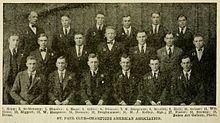
Renamed the Minnesota Twins, the team set up shop in Metropolitan Stadium in Bloomington, a suburb of Minneapolis. Success came quickly to the team in Minnesota. Sluggers Harmon Killebrew[35] and Bob Allison, who had been stars in Washington, were joined by Tony Oliva and Zoilo Versalles, and later second baseman Rod Carew[36] and pitchers Jim Kaat and Jim Perry, winning the American League pennant in 1965.[37] A second wave of success came in the late 1980s and early 1990s under manager Tom Kelly, led by Kent Hrbek, Bert Blyleven,[38] Frank Viola, and Kirby Puckett,[39] winning the franchise's second and third World Series (and first and second in Minnesota).[40]
The name "Twins" was derived from "Twin Cities", a popular nickname for the two cities of Minneapolis and Saint Paul and sometimes used in reference to the entire Minneapolis–Saint Paul metropolitan region. The NBA's Minneapolis Lakers had moved to Los Angeles in 1960 due to poor attendance, blamed in part on a perceived reluctance of fans in Saint Paul to support the team.[41] Griffith was determined not to alienate fans in either city by naming the team after one city or the other. He proposed to name the team the "Twin Cities Twins",[41] but MLB objected and Griffith therefore named the team the Minnesota Twins. The team was allowed to keep its original "TC" (for Twin Cities) insignia for its caps. The team's logo shows two men, one in a Minneapolis Millers uniform and one in a St. Paul Saints uniform, shaking hands across the Mississippi River within an outline of the state of Minnesota. The "TC" remained on the Twins' caps until 1987, when they adopted new uniforms. By this time, the team felt it was established enough to put an "M" on its cap without having Saint Paul fans think it stood for Minneapolis. The "TC" logo was moved to a sleeve on the jerseys, occasionally appeared as an alternate cap design,[42] and then was reinstated as the main cap logo in 2010.[43] Both the "TC" and "Minnie & Paul" logos remain the team's primary insignia.

1960s
[edit]The Twins were eagerly greeted in Minnesota when they arrived in 1961. They brought a nucleus of talented players: Harmon Killebrew,[44] Bob Allison, Camilo Pascual, Zoilo Versalles, Jim Kaat, Earl Battey, and Lenny Green. Tony Oliva, who would go on to win American League batting championships in 1964, 1965 and 1971, made his major league debut in 1962. That year, the Twins won 91 games, the most by the franchise since 1933. Behind Mudcat Grant's 21 victories, Versalles' A.L. MVP season and Oliva's batting title, the Twins won 102 games and the American League Pennant in 1965, but they were defeated in the World Series by the Los Angeles Dodgers in seven games (behind the Series MVP, Sandy Koufax, who compiled a 2–1 record, including winning the seventh game).[45]
In 1962, the Minnesota State Commission on Discrimination filed a complaint against the Twins, which was the only MLB team still segregating players during spring training and when traveling in the southern United States.[46]
Heading into the final weekend of the 1967 season, when Rod Carew was named the A.L. Rookie of the Year, the Twins, Boston Red Sox, Chicago White Sox, and Detroit Tigers all had a shot at clinching the American League championship. The Twins and the Red Sox started the weekend tied for 1st place and played against each other in Boston for the final two games of the season. The Red Sox won both games, seizing their first pennant since 1946 with a 92–70 record. The Twins and Tigers both finished one game back, with 91–71 records, while the White Sox finished three games back, at 89–73. In 1969, the new manager of the Twins, Billy Martin, pushed aggressive base running all-around, with Carew stealing home seven times in the season (1 short of Ty Cobb's Major League Record) in addition to winning the first of seven A.L. batting championships.[47] With Killebrew slugging 49 homers and winning the AL MVP Award, these 1969 Twins won the first American League Western Division Championship, but they lost three straight games to the Baltimore Orioles, winners of 109 games, in the first American League Championship Series. The Orioles would go on to be upset by the New York Mets in the World Series. Martin was fired after the season, in part due to an August 1969 fight in Detroit with 20-game winner Dave Boswell and outfielder Bob Allison, in an alley outside the Lindell A.C. bar. Bill Rigney led the Twins to a repeat division title in 1970, behind the star pitching of Jim Perry (24–12), the A.L. Cy Young Award winner, while the Orioles again won the Eastern Division Championship behind the star pitching of Jim Palmer. Once again, the Orioles won the A.L. Championship Series in a three-game sweep,[48] and this time they would win the World Series.
1970s
[edit]After winning the division again in 1970, the team entered an eight-year dry spell, finishing around the .500 mark. Killebrew departed after 1974. Owner Calvin Griffith faced financial difficulty with the start of free agency, costing the Twins the services of Lyman Bostock and Larry Hisle, who left as free agents after the 1977 season, and Carew, who was traded after the 1978 season.[49] In 1975, Carew won his fourth consecutive AL batting title,[50] having already joined Ty Cobb as the only players to lead the major leagues in batting average for three consecutive seasons. In 1977, Carew batted .388, which was the highest in baseball since Boston's Ted Williams hit .406 in 1941; he won the 1977 AL MVP Award. He won another batting title in 1978, hitting .333.[50]
1980s–90s
[edit]
In 1982, the Twins moved into the Hubert H. Humphrey Metrodome in downtown Minneapolis, which they shared with the Minnesota Vikings. After a 16–54 start, the Twins were on the verge on becoming the worst team in MLB history. They turned the season around somewhat, but still lost 102 games, finishing with what is currently the second-worst record in Twins history (beaten only by the 2016 team, which lost 103 games), despite the .301 average, 23 homers and 92 RBI from rookie Kent Hrbek.[51] In 1984, Griffith sold the Twins to multi-billionaire banker/financier Carl Pohlad. Pohlad beat a larger offer by New York businessman Donald Trump by promising to keep the club in Minnesota.[52] The Metrodome hosted the 1985 Major League Baseball All-Star Game. After several losing seasons, the 1987 team, led by Hrbek, Gary Gaetti, Frank Viola (A.L. Cy Young winner in 1988), Bert Blyleven, Jeff Reardon, Tom Brunansky, Dan Gladden, and rising star Kirby Puckett, returned to the World Series after defeating the favored Detroit Tigers in the ALCS, 4 games to 1. Tom Kelly managed the Twins to World Series victories over the St. Louis Cardinals in 1987[53][54] and the Atlanta Braves in 1991.[55] The 1988 Twins were the first team in American League history to draw more than 3 million fans.[56] On July 17, 1990, the Twins became the only team in major league history to pull off two triple plays in the same game. Twins' pitcher and Minnesota native Jack Morris was the star of the series in 1991, going 2–0 in his three starts with a 1.17 ERA.[57] 1991 also marked the first time that any team that finished in last place in their division would advance to the World Series the following season; both the Twins and the Braves did this in 1991.[58] Contributors to the 1991 Twins' improvement from 74 wins to 95 included Chuck Knoblauch, the A.L. Rookie of the Year; Scott Erickson, 20-game winner; new closer Rick Aguilera and new designated hitter Chili Davis.

The World Series in 1991 is regarded by many as one of the classics of all time. In this Series, four games were won during the teams' final at-bat, and three of these were in extra innings. The Atlanta Braves won all three of their games in Atlanta, and the Twins won all four of their games in Minnesota. Up until then, it was the second time in MLB history when a team won all its home games on their way to winning the World Series. The Twins also did it in 1987. The sixth game was a legendary one for Puckett, who tripled in a run, made a sensational leaping catch against the wall, and finally in the 11th inning hit the game-winning home run. Before Puckett's home run, the Braves brought in Charlie Leibrandt to face him. Chili Davis was on-deck. Puckett told Davis he was going to bunt, and Davis was going to win the game. Davis told him he was going to sit on Leibrandt's change-up and send everyone home. The seventh game was tied 0–0 after the regulation nine innings, and marked only the second time that the seventh game of the World Series had ever gone into extra innings. The Twins won on a walk-off RBI single by Gene Larkin in the bottom of the 10th inning, after Morris had pitched ten shutout innings against the Braves.[59] The seventh game of the 1991 World Series is widely regarded as one of the greatest games in the history of professional baseball.[60][61][62]
After a winning season in 1992 but falling short of Oakland in the division, the Twins fell into a years-long stretch of mediocrity, posting a losing record each season for the next eight: 71–91 in 1993, 50–63 in 1994, 56–88 in 1995, 78–84 in 1996, 68–94 in 1997, 70–92 in 1998, 63–97 in 1999 and 69–93 in 2000. From 1994 to 1997, a long sequence of retirements and injuries hurt the team badly, and Tom Kelly spent the remainder of his managerial career attempting to rebuild the Twins. In 1997, owner Carl Pohlad almost sold the Twins to North Carolina businessman Don Beaver, who would have moved the team to the Piedmont Triad area.[63][64]
Puckett was forced to retire at age 35 due to loss of vision in one eye from a central retinal vein occlusion.[65] The 1989 A.L. batting champion, he retired as the Twins' all-time leader in career hits, runs, doubles, and total bases. At the time of his retirement, his .318 career batting average was the highest by any right-handed American League batter since Joe DiMaggio. Puckett was the fourth baseball player during the 20th century to record 1,000 hits in his first five full calendar years in Major League Baseball, and was the second to record 2,000 hits during his first 10 full calendar years. He was elected to the Baseball Hall of Fame in 2001, his first year of eligibility.
2000s
[edit]
The Twins dominated the Central Division in the first decade of the new century, winning the division in six of those ten years ('02, '03, '04, '06, '09 and '10), and nearly winning it in '08 as well. From 2001 to 2006, the Twins compiled the longest streak of consecutive winning seasons since moving to Minnesota.
Threatened with closure by league contraction,[66] the 2002 team battled back to reach the American League Championship Series before being eliminated 4–1 by that year's World Series champion Anaheim Angels.
In 2006, the Twins won the division on the last day of the regular season (the only day all season they held sole possession of first place) but lost to the Oakland Athletics in the ALDS. Ozzie Guillén coined a nickname for this squad, calling the Twins "little piranhas".[67] The Twins players embraced the label, and in response, the Twins Front office started a "Piranha Night", with piranha finger puppets given out to the first 10,000 fans. Scoreboard operators sometimes played an animated sequence of piranhas munching under that caption in situations where the Twins were scoring runs playing "small ball", and the stadium vendors sold T-shirts and hats advertising "The Little Piranhas". The Twins also had the AL MVP in Justin Morneau,[68] the AL batting champion in Joe Mauer,[67] and the AL Cy Young Award winner in Johan Santana.[69]
In 2008, the Twins finished the regular season tied with the White Sox on top of the AL Central, forcing a one-game playoff in Chicago to determine the division champion.[70] The Twins lost that game and missed the playoffs. The game location was determined by rule of a coin flip that was conducted in mid-September. This rule was changed for the start of the 2009 season, making the site for any tiebreaker game to be determined by the winner of the regular season head-to-head record between the teams involved.[71]
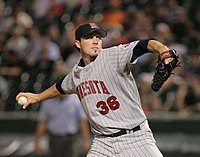
After a year where the Twins played .500 baseball for most of the season, the team won 17 of their last 21 games to tie the Detroit Tigers for the lead in the Central Division.[72] The Twins were able to use the play-in game rule to their advantage when they won the AL Central at the end of the regular season by way of a 6–5 tiebreaker game that concluded with a 12th-inning walk-off hit by Alexi Casilla to right field, that scored Carlos Gómez.[73] However, they failed to advance to the American League Championship Series as they lost the American League Divisional Series in three straight games to the eventual World Series champion New York Yankees.[74] That year, Joe Mauer became only the second catcher in 33 years to win the AL MVP award.[75] Iván Rodríguez won for the Texas Rangers in 1999, previous to that, the last catcher to win an AL MVP was the New York Yankees Thurman Munson in 1976.[76]
2010 marked Minnesota's inaugural season played at Target Field, where the Twins finished the regular season with a record of 94–68, clinching the AL Central Division title for the 6th time in 9 years under manager Ron Gardenhire. New regular players included rookie Danny Valencia at third base, designated hitter Jim Thome,[77] closer Matt Capps,[78] infielder J. J. Hardy,[79] and infielder Orlando Hudson.[80] In relief pitching roles were late additions Brian Fuentes and Randy Flores. On July 7, the team suffered a major blow when Justin Morneau sustained a concussion, which kept him out of the lineup for the rest of the season. In the divisional series, the Twins lost to the Yankees in a three-game sweep for the second consecutive year.[81] Following the season, Ron Gardenhire received AL Manager of the Year honors after finishing as a runner up in several prior years.[82]
2017–present
[edit]In 2017, the Twins went 85–77, finishing 2nd In the AL Central.[83] Following Brian Dozier's 34 home runs,[84] Miguel Sanó, Byron Buxton, and Eddie Rosario all had breakout years, while Joe Mauer hit .305. They ended up making the playoffs,[85] which made them the first ever team to lose 100 games the previous year and make the playoffs the next season.[86] They lost to the Yankees in the wild card round.[87]
The 2018 season did not go as well. The Twins went 78–84, and did not return to the post-season. Sanó and Buxton were injured most of the year and eventually both sent down to the minors, while long-time Twin Brian Dozier was traded at the deadline.[88] One bright spot came at the end of the season, when hometown hero Joe Mauer returned to catcher (his original position) for his final game, ending his career with a signature double and standing ovation.[89] Another highlight was the team's two-game series against the Cleveland Indians in San Juan, Puerto Rico.[90][91] After the season, manager Paul Molitor was fired.[92] Free agent signing Logan Morrison and long-time veteran Ervin Santana declared free agency.[93]
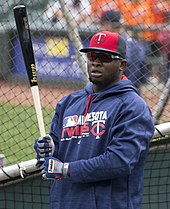
In 2019, the Twins clinched the AL Central Division for the first time since 2010, finishing the season with the second-most wins in franchise history with 101, one short of the 1965 season.[94][circular reference] The team combined for a total of 307 home runs, the most in MLB history for a single season.[95] The team's slugging prowess has earned them the nickname the Bomba Squad.[96] In the 2019 ALDS, the Twins opponents were the New York Yankees, who finished one home run behind at 306 and the second team to break the 300 home run mark. The Twins were swept again, and extend their postseason losing streak to 16, dating back to the 2004 ALDS.[97] On September 17, 2019, Miguel Sanó hit a 482-foot home run to make the Twins the first team in major league history to have five players with at least 30 home runs in a season.[98]
In 2023 the Minnesota Twins struggled through the first half, falling under .500 just before the All-Star break before beginning a late season surge that saw them take control of the AL Central. They finished as the third seed in the AL for the 2023 MLB Playoffs and faced the Toronto Blue Jays in the AL Wild Card round. Behind dominant pitching they won both of the first 2 games in the 3 game series, winning their first playoff game since 2004 (breaking an 0–18 postseason streak, the longest in North American sports history) and winning their first playoff series since the 2002 ALDS against the Oakland Athletics.
Threats to move or disband the team
[edit]The quirks of the Hubert H. Humphrey Metrodome, including the turf floor and the white roof, gave the Twins a home-field advantage that helped them win the World Series in 1987 and 1991, at least in the opinion of their opponents. The Twins went 12–1 in postseason home games during those two seasons,[99] becoming the first and second teams to sweep all four home games in a World Series.[100] (The feat was repeated by the Arizona Diamondbacks in 2001.) Nevertheless, the Twins argued that the Metrodome was obsolete. Furthermore, they said sharing a stadium with the NFL's Minnesota Vikings, as they had been doing since their 1961 move to Minnesota, limited the team's revenue and made it difficult to sustain a top-notch, competitive team. The team was rumored to contemplate moving to New Jersey, Las Vegas, Portland, Oregon, the Greensboro/Winston-Salem, North Carolina area, and elsewhere in search of a more financially competitive market. In 2002, the team was nearly disbanded when Major League Baseball selected the Twins and the Montreal Expos (now the Washington Nationals franchise) for elimination due to their financial weakness. The impetus for league contraction diminished after a court decision forced the Twins to play out their lease on the Metrodome. However, Twins owner Carl Pohlad continued his efforts to move, pursuing litigation against the Metropolitan Stadium Commission and obtaining a state court ruling that his team was not obligated to play in the Metrodome after the 2006 season. This cleared the way for the Twins to move or disband before the 2007 season if a new deal was not reached.
Target Field
[edit]
In response to the threatened loss of the Twins, the Minnesota private and public sector negotiated and approved a financing package for a replacement stadium— a baseball-only outdoor, natural turf ballpark in the Warehouse District of downtown Minneapolis— owned by a new entity known as the Minnesota Ballpark Authority.[101] Target Field was constructed at a cost of $544.4 million (including site acquisition and infrastructure), utilizing the proceeds of a $392 million public bond offering based on a 0.15% sales tax in Hennepin County and private financing of $185 million provided by the Pohlad family.[102][103] As part of the deal, the Twins also signed a 30-year lease of the new stadium, effectively guaranteeing the continuation of the team in Minnesota for a long time to come. Construction of the new field began in 2007, and was completed in December 2009, in time for the 2010 season. Commissioner Bud Selig, who earlier had threatened to disband the team, observed that without the new stadium the Twins could not have committed to sign their star player, catcher Joe Mauer, to an 8-year, $184 million contract extension. The first regular-season game in Target Field was played against the Boston Red Sox on April 12, 2010, with Mauer driving in two runs and going 3-for-5 to help the Twins defeat the Red Sox, 5–2.[104]
On May 18, 2011, Target Field was named "The Best Place To Shop" by Street and Smith's SportsBusiness Journal at the magazine's 2011 Sports Business Awards Ceremony in New York City.[105] It was also named "The Best Sports Stadium in North America" by ESPN The Magazine in a ranking that included over 120 different stadiums, ballparks and arenas from around North America.[106] The stadium hosted the 85th Major League Baseball All-Star Game and the Home Run Derby in 2014. In mid 2020, following protests over the murder of George Floyd, a statue of former owner Calvin Griffith was removed from Target Plaza outside of the stadium due to his history of racist comments.[107]
Uniforms
[edit]Current
[edit]Starting in 2023, the Twins made a drastic overhaul to their uniforms. The white home uniform features the updated "Twins" script (with the underline below "win") in red with navy numbers. On the back, the player names are in navy and numbers are in red. On the left sleeve, the Minnesota state map in navy was added with a red star to represent the Twin Cities of Minneapolis–St. Paul. The home cap is all-navy with the updated "TC" insignia.[108] The home helmet is navy with a white panel and red brim and features the new "TC" insignia.[109]
Road gray uniforms featured an all-caps "MINNESOTA" in navy with red numbers. On the back, the player names are in navy and numbers are in red. Likewise, the new navy Minnesota map with red star was featured on the left sleeve. Navy pinstripes were also added. The road cap is also all-navy, but with the white "M" and a red star on top representing the north star; this design also serves as the basis of their road batting helmet.[108][110]
The alternate navy uniforms, worn both at home and on the road, has the all-caps "MINNESOTA" in white with red numbers. On the back, player names are also rendered in white while numbers are in red. The left sleeve features the updated "TC" insignia. The uniforms are paired with the road all-navy "M" cap with red star, with the white-paneled "TC" helmet used on home games and the "M" all-navy helmet used on the road.[108][109][110]
The alternate home cream uniform featured a new "Twin Cities" wordmark (with the underline below "win Citie") in navy. The set, which lacked red, also featured two crossed navy flags representing both Minneapolis ("M") and St. Paul ("STP"). An alternate all-navy cap with the "TC" insignia is used, except the "TC" is in cream and also lacked red elements. This design also became the basis of the all-navy alternate home "TC" helmet.[108][110]
Added in 2024 is a City Connect uniform, visually representing the state's nickname of "Land of 10,000 Lakes". The predominantly sublimated blue uniform with yellow accents featured the "MN" abbreviation on the left chest, with the yellow four-point star representing the north star. The sleeve patch contained a loon flying through ripples of water, with baseball stitching comprising the eyes and the north star representing its beak. Caps are blue with yellow brim, and contained the Minnesota state outline with a yellow star representing the Twin Cities and the northern lights reflected in a water line of a lake. The right side of the caps featured the "10,000 Lakes" moniker. [111]
Past uniforms
[edit]From 1961 to 1971 the Twins sported uniforms bearing the classic "Twins" script and numerals in navy outlined in red. They wore navy caps with an interlocking "TC" on the front; this was adopted because Griffith was well aware of the bitter rivalry between Minneapolis and Saint Paul and didn't want to alienate fans in either city. The original "Minnie and Paul" alternate logo appears on the left sleeve of both the pinstriped white home uniform and gray road uniform.[112]
For the 1972 season the Twins updated their uniforms. The color scheme on the "Twins" script and numerals were reversed, pinstripes were removed from the home uniform, and an updated "Minnie and Paul" roundel patch replaced the originals on the left sleeve.[112]
In 1973, the Twins switched to polyester pullover uniforms, which included a powder blue road uniform. Chest numerals were added while a navy-brimmed red cap was used with the home uniform. The original "Minnie and Paul" logo returned to the left sleeve. Player names in red were added to the road uniform in 1977.[112]
In 1987, the Twins updated their look. Home white uniforms brought back the pinstripes along with the modern-day "Twins" script. By this time, the franchise felt it was established enough in the area that it could put a stylized "M" on its cap without having fans in St. Paul think it stood for Minneapolis. The "TC" insignia adorned the left sleeve, later replaced by the modern "Minnie and Paul" alternate in 2002. Road gray uniforms, which also featured pinstripes, were emblazoned with "Minnesota" in red block letters outlined in navy, while the updated primary logo adorned the left sleeve. Both uniforms kept the red numerals trimmed in navy, but the color on the player names was changed to navy. In 1997, player names were added to the home uniform. Initially, both uniforms were paired with an all-navy cap featuring the underlined "M" in front, but in 2002, the "TC" cap was brought back as a home cap while the "M" cap was used on the road. The "M" cap was retired following the 2010 season, though the team continued to wear them as a throwback on special occasions.[112]
For a few games during the 1997 season, the Twins wore red alternate uniforms, which featured navy piping and letters in white trimmed in navy. In that same year, the Twins also released a road navy alternate uniform, featuring red piping, "Minnesota" and player names in white block letters outlined in red, and red numerals outlined in white. The following season, the Twins replaced the red uniforms with a home navy alternate, which features the "Twins" script and back numerals in red outlined in white, and player names and chest numerals in white outlined in red. Both uniforms contained the "TC" (later modern "Minnie and Paul") and primary logo sleeve patches respectively. The Twins also brought back the navy-brimmed red cap for a few games with the home navy alternates. The road navy alternates remained in use until 2009, with the home navy version worn for the last time in the 2013 season.[112]
The Twins also wore three other alternate uniforms in the past. In 2006, the Twins wore a sleeveless variation of their regular home uniforms with navy undershirts, which they wore until 2010. They also wore a buttoned version of their 1973–86 home uniforms in 2009, before giving way to the throwback off-white version of their 1961–71 home uniforms from 2010 to 2018.[112]
In 2010, the Twins modified their road uniforms upon moving to Target Field. The pinstriped home uniforms remained, but the road primary now featured an updated "Minnesota" script (with an underline below "innesot") in red trimmed in navy. Letters are in navy while numerals (both on the chest and on the back) are in red trimmed in navy. The team's primary logo appears on the left sleeve. Meanwhile, the navy alternate road uniform shared the same look as the regular road uniforms, but with a few differences. The "Minnesota" script is in red outlined in white, letters and chest numerals are in white outlined in red, and back numerals are in red outlined in white. Red piping is also added. Both uniforms were paired with either the all-navy or the red-brimmed navy "TC" cap.[112]
In 2015, the Twins changed their home uniform. It features the modern "Twins" script (with an underline below "win") in navy outlined in red with Kasota gold drop shadows. Letters and numerals also take on the same color as the "Twins" script. The modern "Minnie and Paul" alternate logo (with the state of Minnesota in navy outlined in Kasota gold) appears on the left sleeve. Caps are in all-navy with the interlocking "TC" outlined in Kasota gold. The following year, they unveiled a red alternate uniform, which features the "TC" insignia outlined in Kasota gold on the left chest. Letters and numerals are in navy outlined in white with Kasota gold drop shadows. The "Minnie and Paul" alternate logo appears on the left sleeve. The uniform is paired with a navy-brimmed red cap with the "TC" outlined in Kasota gold.[112]
In 2019, a new home navy alternate was released, featuring the classic "Twins" script (with a tail underline accent after the letter "s") in red outlined in navy and Kasota gold. Letters and numerals also take on the same color as the "Twins" script. As with the home white uniforms, it is paired with the all-navy Kasota gold "TC" cap. The gold-trimmed "TC" insignia also appears on the left sleeve.[113] The following year, a throwback-inspired powder blue uniform was unveiled. A modern buttoned version of the road uniform the team used from 1973 to 1986, the set contains the classic "Twins" script in red outlined in navy, along with red letters on the back and red numerals (both on the chest and on the back) outlined in navy. The "Minnie and Paul" alternate logo appears on the left sleeve. The uniform is paired with the primary all-navy "TC" cap minus the Kasota gold accents, which is also used on the helmets regardless of uniform.[114]
Roster
[edit]| 40-man roster | Non-roster invitees | Coaches/Other | ||||
|---|---|---|---|---|---|---|
|
Pitchers
|
Catchers Infielders
Outfielders
|
|
Manager Coaches
39 active, 0 inactive, 0 non-roster invitees
| |||
Minnesota Twins all-time roster: A complete list of players who played in at least one game for the Twins franchise.
Minor league affiliates
[edit]The Minnesota Twins farm system consists of six minor league affiliates.[115]
| Class | Team | League | Location | Ballpark | Affiliated |
|---|---|---|---|---|---|
| Triple-A | St. Paul Saints | International League | Saint Paul, Minnesota | CHS Field | 2021 |
| Double-A | Wichita Wind Surge | Texas League | Wichita, Kansas | Riverfront Stadium | 2021 |
| High-A | Cedar Rapids Kernels | Midwest League | Cedar Rapids, Iowa | Veterans Memorial Stadium | 2013 |
| Single-A | Fort Myers Mighty Mussels | Florida State League | Fort Myers, Florida | Hammond Stadium | 1993 |
| Rookie | FCL Twins | Florida Complex League | Fort Myers, Florida | Lee County Sports Complex | 1989 |
| DSL Twins | Dominican Summer League | Boca Chica, Santo Domingo | Baseball City Complex | 2001 |
Achievements
[edit]Baseball Hall of Fame members
[edit]| Minnesota Twins Hall of Famers | ||||||||||||||||||
|---|---|---|---|---|---|---|---|---|---|---|---|---|---|---|---|---|---|---|
| Affiliation according to the National Baseball Hall of Fame and Museum | ||||||||||||||||||
|
Molitor, Morris, and Winfield were all St. Paul natives who joined the Twins late in their careers and were warmly received as "hometown heroes", but were elected to the hall primarily on the basis of their tenures with other teams. Both Molitor and Winfield had their 3,000th hit with Minnesota,[116][117][118] while Morris pitched a complete-game shutout for the Twins in game seven of the 1991 World Series. Molitor was the first player in history to hit a triple for his 3,000th hit.
Cronin, Goslin, Griffith, Harris, Johnson, Killebrew and Wynn are listed on the Washington Hall of Stars display at Nationals Park (previously they were listed at Robert F. Kennedy Stadium). So are Ossie Bluege, George Case, Joe Judge, George Selkirk, Roy Sievers, Cecil Travis, Mickey Vernon and Eddie Yost.[119]
Ford C. Frick Award recipients
[edit]




| Minnesota Twins Ford C. Frick Award recipients | |||||||||
|---|---|---|---|---|---|---|---|---|---|
| Affiliation according to the National Baseball Hall of Fame and Museum | |||||||||
|
Team captains
[edit]- 3 Harmon Killebrew 1961–74
Twins Hall of Fame
[edit]| Year | Year inducted |
|---|---|
| Bold | Member of the Baseball Hall of Fame |
†
|
Member of the Baseball Hall of Fame as a Twin |
| Bold | Recipient of the Hall of Fame's Ford C. Frick Award |
| Minnesota Twins Hall of Fame | ||||
| Year | No. | Name | Position(s) | Tenure |
|---|---|---|---|---|
| 2000 | 3 | Harmon Killebrew† | 1B | 1961–1974 |
| 29 | Rod Carew† | 2B | 1967–1978 | |
| 6 | Tony Oliva† | RF/DH | 1962–1976 | |
| 14 | Kent Hrbek | 1B | 1981–1994 | |
| 34 | Kirby Puckett† | CF | 1984–1995 | |
| — | Calvin Griffith | President and Owner | 1961–1984 | |
| 2001 | — | Herb Carneal† | Radio Broadcaster | 1962–2007 |
| 36 | Jim Kaat† | P | 1961–1973 | |
| 2002 | 28 | Bert Blyleven† | P | 1970–1976 1985–1988 |
| 10 | Tom Kelly | Manager | 1986–2001 | |
| 2003 | 4 | Bob Allison | OF | 1961–1970 |
| — | Bob Casey | Public Address Announcer | 1961–2004 | |
| 2004 | 10 | Earl Battey | C | 1961–1967 |
| 2005 | 16 | Frank Viola | P | 1982–1989 |
| — | Carl Pohlad | Owner | 1984–2009 | |
| 2006 | 2 | Zoilo Versalles | SS | 1961–1967 |
| 2007 | 8 | Gary Gaetti | 3B | 1981–1990 |
| — | Jim Rantz | Director of Minor Leagues | 1986–2012 | |
| 2008 | 38 | Rick Aguilera | P | 1989–1995 1996–1999 |
| 2009[120] | 22, 23, 59 | Brad Radke | P | 1995–2006 |
| — | George Brophy | Front office executive | 1961–1985 | |
| 2010[121] | 7 | Greg Gagne | SS | 1983–1992 |
| 2011[122] | 31 | Jim Perry | P | 1963–1972 |
| 2012[123] | 17 | Camilo Pascual | P | 1961–1966 |
| 2013[124] | 18 | Eddie Guardado | P | 1993–2003, 2008 |
| — | Tom Mee | Media Relations Director | 1961–1991 | |
| 2016 | — | John Gordon | Radio Broadcaster | 1987–2011 |
| 48 | Torii Hunter | CF/RF | 1997–2007, 2015 | |
| 2017 | 5 | Michael Cuddyer | RF | 2001–2011 |
| — | Andy MacPhail | General Manager | 1985–1994 | |
| 2018 | 57 | Johan Santana | P | 2000–2007 |
| 2019 | 36 | Joe Nathan | P | 2004–2009, 2011 |
| — | Jerry Bell | President | 1987–2002 | |
| 2020 | 33 | Justin Morneau | 1B | 2003–2013 |
| 2022 | 35 | Ron Gardenhire | Coach/Manager | 1991–2001 2002–2014 |
| 32 | Dan Gladden | LF | 1987–1991 | |
| 12 | César Tovar | IF/OF | 1965–1972 | |
| 2023 | 7 | Joe Mauer† | C/1B | 2004–2018 |
| 2024 | Terry Ryan | GM | 1994–2007, 2011–2016 | |
| 43 | Rick Stelmaszek | Coach | 1981–2012 | |
Chuck Knoblauch was voted into the Twins Hall of Fame in 2014, but due to his legal troubles the team canceled his induction.[125]
Retired numbers
[edit]The Metrodome's upper deck in center and right fields was partly covered by a curtain containing banners of various titles won, and retired numbers. There was no acknowledgment of the Twins' prior championships in Washington and several Senator Hall of Famers, such as Walter Johnson, played in the days prior to numbers being used on uniforms. However, Killebrew played seven seasons as a Senator, including two full seasons as a regular prior to the move to Minnesota in 1961.
Prior to the addition of the banners, the Twins acknowledged their retired numbers on the Metrodome's outfield fence. Harmon Killebrew's #3 was the first to be displayed, as it was the only one the team had retired when they moved in. It was joined by Rod Carew's #29 in 1987, Tony Oliva's #6 in 1991, Kent Hrbek's #14 in 1995, and Kirby Puckett's #34 in 1997 before the Twins began hanging the banners to reduce capacity. The championships, meanwhile, were marked on the "Baggie" in right field.
|

In the Metrodome, the numbers ran in that order from left to right. In Target Field, they run from right to left, presumably to allow space for additional numbers in the future. The retired numbers also serve as entry points at Target Field, The center field gate is Gate No. 3, honoring Killebrew, the left-field gate is Gate No. 6, honoring Oliva, the home plate gate is Gate No. 14, for Hrbek, the right field gate serves as Gate No. 29, in tribute to Carew, and the plaza gate is known as Gate No. 34, honoring Puckett.
The numbers that have been retired hang within Target Field in front of the tower that serves as the Twins' executive offices in left field foul territory. The championships banners have been replaced by small pennants that fly on masts at the back of the left-field upper deck. Those pennants, along with the flags flying in the plaza behind right field, serve as a visual cue for the players, suggesting the wind direction and speed.
Jackie Robinson's No. 42 was retired by Major League Baseball on April 15, 1997, and formally honored by the Twins on May 23, 1997.[126] Robinson's number was positioned to the left of the Twins numbers in both venues.
| Player | Jersey | Position | Date retired |
|---|---|---|---|
| Harmon Killebrew | 3 | LF-1B-3B: 1954–60 (WSH) LF-1B-3B: 1961–74 (MIN) |
May 4, 1975 |
| Rod Carew | 29 | 1B-2B: 1967–78 (MIN) | July 19, 1987 |
| Tony Oliva | 6 | RF-DH: 1962–76 (MIN) Coach: 1976–78 (MIN) Coach: 1985–91 (MIN) |
July 14, 1991 |
| Kent Hrbek | 14 | 1B: 1981–94 (MIN) | August 13, 1995 |
| Jackie Robinson | 42 | Retired by MLB | April 15, 1997 |
| Kirby Puckett | 34 | CF: 1984–95 (MIN) | May 25, 1997 |
| Bert Blyleven | 28 | P: 1970–76 (MIN) P: 1985–88 (MIN) |
July 16, 2011 |
| Tom Kelly | 10 | Manager: 1986–2001 (MIN) | September 8, 2012 |
| Joe Mauer | 7 | C-1B-DH: 2004–2018 (MIN) | June 15, 2019 |
| Jim Kaat | 36 | P: 1959–60 (WSH) P: 1961–73 (MIN) |
July 16, 2022 |
Awards
[edit]Team records
[edit]Team seasons
[edit]| Year | Regular Season | Postseason | Result | ||||||
|---|---|---|---|---|---|---|---|---|---|
| Wins | Losses | Win % | Finish | Attendance | Attendance per Game | Record | Win % | ||
| 2001 | 85 | 77 | .525 | 2nd – AL Central | 1,782,929 | 22,011 | — | — | |
| 2002 | 94 | 67 | .584 | 1st – AL Central | 1,924,473 | 23,906 | 4–6 | .400 | Won ALDS vs Oakland Athletics, 3–2 Lost ALCS to Anaheim Angels, 1–4 |
| 2003 | 90 | 72 | .556 | 1st – AL Central | 1,946,011 | 24,025 | 1–3 | .250 | Lost ALDS to New York Yankees, 1–3 |
| 2004 | 92 | 70 | .568 | 1st – AL Central | 1,911,490 | 23,599 | 1–3 | .250 | Lost ALDS to New York Yankees, 1–3 |
| 2005 | 83 | 79 | .512 | 3rd – AL Central | 2,034,243 | 25,114 | — | — | |
| 2006 | 96 | 66 | .593 | 1st – AL Central | 2,285,018 | 28,210 | 0–3 | .000 | Lost ALDS to Oakland Athletics, 0–3 |
| 2007 | 79 | 83 | .488 | 3rd – AL Central | 2,296,347 | 28,349 | — | — | |
| 2008 | 88 | 75 | .540 | 2nd – AL Central | 2,302,611 | 28,427 | — | — | |
| 2009 | 87 | 76 | .534 | 1st – AL Central | 2,416,237 | 29,466 | 0–3 | .000 | Lost ALDS to New York Yankees, 0–3 |
| 2010 | 94 | 68 | .580 | 1st – AL Central | 3,223,640 | 39,798 | 0–3 | .000 | Lost ALDS to New York Yankees, 0–3 |
| 2011 | 63 | 99 | .389 | 5th – AL Central | 3,168,107 | 39,112 | — | — | |
| 2012 | 66 | 96 | .407 | 5th – AL Central | 2,776,354 | 34,275 | — | — | |
| 2013 | 66 | 96 | .407 | 4th – AL Central | 2,477,644 | 30,588 | — | — | |
| 2014 | 70 | 92 | .432 | 5th – AL Central | 2,250,606 | 27,785 | — | — | |
| 2015 | 83 | 79 | .521 | 2nd – AL Central | 2,220,054 | 27,408 | — | — | |
| 2016 | 59 | 103 | .364 | 5th – AL Central | 1,963,912 | 24,246 | — | — | |
| 2017 | 85 | 77 | .525 | 2nd – AL Central | 2,051,279 | 25,324 | 0–1 | .000 | Lost AL Wild Card Game (Yankees) |
| 2018 | 78 | 84 | .481 | 2nd – AL Central | 1,959,197 | 24,489 | — | — | |
| 2019 | 101 | 61 | .623 | 1st – AL Central | 2,294,152 | 28,322 | 0–3 | .000 | Lost ALDS to New York Yankees, 0–3 |
| 2020 | 36 | 24 | .600 | 1st – AL Central | 0 | 0 | 0–2 | .000 | Lost ALWCS to Houston Astros, 0–2 |
| 2021 | 73 | 89 | .451 | 5th – AL Central | 1,310,199 | 16,377 | — | — | |
| 2022 | 78 | 84 | .481 | 3rd – AL Central | 1,801,128 | 22,236 | — | — | |
| 2023 | 87 | 75 | .537 | 1st – AL Central | 1,974,124 | 24,372 | 3–3 | .500 | Won ALWCS vs Toronto Blue Jays, 2–0 Lost ALDS to Houston Astros, 1–3 |
| Total as Twins | 4954 | 5011 | .497 | – | – | – | 28–45 | .384 | 2 World Series Championships |
Radio and television
[edit]In 2007, the Twins took the rights to the broadcasts in-house and created the Twins Radio Network (TRN). With that new network in place the Twins secured a new Metro Affiliate flagship radio station in KSTP (AM 1500). It replaced WCCO (AM 830), which held broadcast rights for the Twins since the team moved to Minneapolis in 1961. For 2013, the Twins moved to FM radio on KTWN-FM 96.3 K-Twin, which is owned by the Pohlad family. The original radio voices of the Twins in 1961 were Ray Scott, Halsey Hall and Bob Wolff. After the first season, Herb Carneal replaced Wolff. Twins TV and radio broadcasts were originally sponsored by the Hamm's Brewing Company. In 2009, Treasure Island Resort & Casino became the first-ever naming rights partner for the Twins Radio Network, making the commercial name of TRN the Treasure Island Baseball Network.[129] In 2017, it was announced that WCCO would become the flagship station the Twins again starting in 2018, thus returning the team back to its original station after 11 years.[130]
Cory Provus is the current radio play by play announcer,[131] taking over in 2012 for longtime Twins voice John Gordon who retired following the 2011 season.[132] Former Twins OF Dan Gladden serves as color commentator.[133]
TRN broadcasts are originated from the studios at Minnesota News Network and Minnesota Farm Networks. Kris Atteberry hosts the pre-game show, the "Lineup Card" and the "Post-game Download" from those studios except when filling in for Provus or Gladden when they are on vacation.
On April 1, 2007, Herb Carneal, the radio voice of the Twins for all but one year of their existence, died at his home in Minnetonka after a long battle with a list of illnesses. Carneal is in the broadcasters wing of the Baseball Hall of Fame.[134]
In October 2024, as a result of bankruptcy proceedings involving former broadcaster Diamond Sports Group, Major League Baseball's local media division announced that it would take over the production and distribution of Twins games starting with the 2025 season.[135]

Prior to 2025, the television rights were held by Bally Sports North[136] with Dick Bremer as the play-by-play announcer. Former Twins players Roy Smalley, Justin Morneau, Glen Perkins, and LaTroy Hawkins served as analysts.[137]
In 2024, the Twins announced that Provus would move to TV play-by-play following the retirement of Dick Bremer who eventually moved to an advisory role in the front office. Atteberry replaced Provus on the radio side.[138]
Bob Casey was the Twins first public-address announcer starting in 1961 and continuing until his death in 2005. He was well known for his unique delivery and his signature announcements of "No smoking in the Metrodome, either go outside or quit!" (or "go back to Boston", etc.), "Batting 3rd, the center-fielder, No. 34, Kirby Puckett!!!" and asking fans not to 'throw anything or anybody' onto the field.[139]
Community activities
[edit]- Minnesota Twins Community Fund – Play Ball! Minnesota[140]
Team and franchise traditions
[edit]Fans wave a Homer Hanky to rally the team during play-offs and other crucial games. The Homer Hanky was created by Terrie Robbins of the Star Tribune newspaper in the Twin Cities in 1987. It was her idea to originally give away 60,000 inaugural Homer Hankies. That year, over 2.3 million Homer Hankies were distributed.[141]
The party atmosphere of the Twins clubhouse after a win is well known,[142] the team's players unwinding with loud rock music (usually the choice of the winning pitcher) and video games.[142]
The club has several hazing rituals, such as requiring the most junior relief pitcher on the team to carry water and snacks to the bullpen in a brightly colored small child's backpack (Barbie in 2005, SpongeBob SquarePants in 2006, Hello Kitty in 2007, Disney Princess and Tinkerbell in 2009, Chewbacca and Darth Vader in 2010),[142] and many of its players, both past and present, are notorious pranksters.[142] For example, Bert Blyleven earned the nickname "The Frying Dutchman" for his ability to pull the "hotfoot" – which entails crawling under the bench in the dugout and lighting a teammate's shoelaces on fire.[143][144]
The team introduced T.C. Bear, its costumed mascot, on April 3, 2000.[145]
Minnesota Twins in popular culture
[edit]- In Little Big League, the Minnesota Twins is inherited by a 12-year-old boy who goes on to manage the team.
- In Terminator 2: Judgment Day, Danny, the son of Miles Dyson, wears a Minnesota Twins cap. The movie was released in 1991, which was the same year the Twins won the World Series.
- In Major League: Back to the Minors, the character Roger Dorn, from previous Major League movies, is owner of the Minnesota Twins.
- In the 1997 film McHale's Navy, Lt. Commander Quinton McHale wears a Minnesota Twins cap.
Notes
[edit]- ^ Known as National Park from 1911 to 1920.
References
[edit]- ^ Park, Do-Hyuong (November 18, 2022). "Twins honor past, greet future with new uniforms". MLB.com. MLB Advanced Media. Archived from the original on November 18, 2022. Retrieved November 19, 2022.
The core red, white and blue color scheme remains, but the hues themselves have been slightly tweaked with a more vibrant red and a darker navy blue -- almost bordering on black -- to accentuate contrasts and unify the color scheme, particularly with the caps. The Kasota Gold of the most recent color scheme is gone, as are drop shadows, outlines and the like, leading to a much sleeker, more unified design.
- ^ "Inspired by the past, built for the future: Minnesota Twins unveil new marks and uniforms". MLB.com (Press release). MLB Advanced Media. November 18, 2022. Archived from the original on November 19, 2022. Retrieved November 19, 2022.
Lastly, the Twins' legacy color palette – embraced by the franchise since the Washington Senators debuted in 1901 – has been modernized with a slightly brighter shade of red, a boldly dark navy blue and a more brilliant sheen of white.
- ^ "Home Uniforms". Twins.com. MLB Advanced Media. Archived from the original on November 8, 2023. Retrieved November 8, 2023.
Featuring a contemporized "Twins" script recalling beloved elements of yesteryear, the return of a piping pattern first popularized by the Rod Carew-era clubs and rekindled with Joe Mauer's 2009 American League Most Valuable Player campaign, and the introduction of the Twins' exclusive new font – all presented in a crisp and dynamic aesthetic celebrating the club's modernized red, white and navy-blue palette – the new home uniform is a passionate, innovative and bold embodiment of baseball and community in Twins Territory.
- ^ "Jim Pohlad steps down, Joe Pohlad new executive chairman". mlb.com. Archived from the original on January 11, 2023. Retrieved January 11, 2023.
- ^ Randhawa, Manny (October 25, 2018). "Twins tab Rocco Baldelli as new manager". TwinsBaseball.com. MLB Advanced Media. Archived from the original on October 25, 2018. Retrieved July 13, 2019.
- ^ "Minnesota Twins name Derek Falvey Executive Vice President, Chief Baseball Officer". TwinsBaseball.com (Press release). MLB Advanced Media. October 3, 2016. Archived from the original on October 28, 2016. Retrieved October 4, 2016.
- ^ E. Neal, La Velle III (October 3, 2016). "Derek Falvey officially named Twins' chief baseball officer". Star Tribune. Archived from the original on October 5, 2016. Retrieved October 4, 2016.
- ^ Park, Do-Hyung (December 1, 2021). "Here's the story behind the Twins' name". Twins.com. MLB Advanced Media. Archived from the original on November 1, 2023. Retrieved November 1, 2023.
- ^ "Minnesota Twins Move Into Target Field". TwinsBaseball.com (Press release). MLB Advanced Media. January 4, 2010. Archived from the original on January 9, 2010. Retrieved February 17, 2018.
- ^ "Remembering the Washington Senators' 1924 World Series". Bleacher Report. October 27, 2012. Archived from the original on May 26, 2019. Retrieved May 25, 2019.
- ^ "Minnesota Twins Team History & Encyclopedia". Baseball Reference. Sports Reference. Archived from the original on March 2, 2011. Retrieved September 30, 2024.
- ^ Fleming, Frank. "Sports Encyclopedia". Archived from the original on October 22, 2020. Retrieved September 8, 2020.
- ^ "Damn Yankees". The Broadway Musical Home. Archived from the original on October 3, 2012. Retrieved August 14, 2012.
- ^ "1911 Washington Senators". Baseball-Reference.com. Archived from the original on May 3, 2012. Retrieved April 30, 2012.
- ^ "1912 Washington Senators". Baseball-Reference.com. Archived from the original on May 2, 2012. Retrieved April 30, 2012.
- ^ "Griffith, Clark". Baseball Hall of Fame. Archived from the original on July 12, 2011. Retrieved August 14, 2012.
- ^ Goldstein, Richard (October 21, 1999). "Calvin Griffith, 87, Is Dead; Tight-Fisted Baseball Owner". The New York Times. Archived from the original on May 2, 2015. Retrieved February 11, 2017.
- ^ "1913 American League Team Statistics and Standings". Baseball-Reference.com. Archived from the original on August 29, 2018. Retrieved April 30, 2012.
- ^ "Johnson, Walter". Baseball Hall of Fame. Archived from the original on December 14, 2010. Retrieved August 14, 2012.
- ^ "1924 American League Team Statistics and Standings". Baseball-Reference.com. Archived from the original on June 11, 2009. Retrieved April 30, 2012.
- ^ "1924 World Series". Baseball-Reference.com. Archived from the original on November 12, 2020. Retrieved April 29, 2012.
- ^ 1924 World Series Archived November 7, 2020, at the Wayback Machine, Baseball Almanac. Includes box scores for all seven games of the 1924 World Series.
- ^ History of baseball in D.C., on MLB.com but not subject to the approval of Major League Baseball, September 29, 2004.
- ^ a b "1924 World Series Game 7 box score". Baseball-Reference.com. Archived from the original on August 30, 2012. Retrieved April 29, 2012.
- ^ a b c Ruel, Muddy (October 1964). How Senators' Strategy Won for Johnson. Retrieved April 29, 2012.
{{cite book}}:|work=ignored (help)[permanent dead link] - ^ "Washington Senators". baseballbiography.com. Retrieved August 7, 2009.
- ^ Grosshandler, Stan (February 1981). 13 Most Forgotten Stars In Major League History. Retrieved May 3, 2012.
{{cite book}}:|work=ignored (help)[permanent dead link] - ^ Vass, George (August 1999). 20th Century All-Overlooked Stars. Retrieved May 3, 2012.
{{cite book}}:|work=ignored (help)[permanent dead link] - ^ "Senators Reject Bids to Move to Minneapolis or St. Paul". The New York Times. October 27, 1957. Archived from the original on July 23, 2018. Retrieved May 2, 2008.
- ^ The American League in Transition, 1965–1975: How Competition Thrived When the Yankees Didn't Archived April 5, 2023, at the Wayback Machine, Paul Hensley, McFarland & Co. Publishers, 2013.
- ^ The American League in Transition, 1965–1975, Paul Hensley, page 13, "Along with a potential to gain over twice as much profit from the sale of television and radio . . " Archived April 5, 2023, at the Wayback Machine.
- ^ The cost of baseball's broadcast rights in 1961 Archived November 5, 2019, at the Wayback Machine, SBNation, Larry Granillo, August 29, 2013. In the 1961 season, the new Washington Senators received $300,000 for TV and radio broadcast rights, whereas the Minnesota Twins (old Senators) received $550,000 for the broadcast rights. Please see chart.
- ^ "Texas Rangers on Baseball Almanac". Baseball-almanac.com. Archived from the original on November 21, 2014. Retrieved August 14, 2012.
- ^ "The short history of the Minnesota Twins' Calvin Griffith memorial". MinnPost.com. September 20, 2021. Archived from the original on September 27, 2021. Retrieved November 6, 2022.
- ^ "Killebrew, Harmon". Baseball Hall of Fame. Archived from the original on October 12, 2011. Retrieved August 14, 2012.
- ^ "Carew, Rod". Baseball Hall of Fame. Archived from the original on July 12, 2011. Retrieved August 14, 2012.
- ^ "1965 Minnesota Twins Batting, Pitching, & Fielding Statistics". Baseball-Reference.com. Archived from the original on August 9, 2017. Retrieved August 14, 2012.
- ^ "Blyleven, Bert". Baseball Hall of Fame. Archived from the original on August 18, 2012. Retrieved August 14, 2012.
- ^ "Puckett, Kirby". Baseball Hall of Fame. Archived from the original on July 17, 2011. Retrieved August 14, 2012.
- ^ "Kirby Puckett & Your 1987 And 1991 World Series Championship Winning Minnesota Twins | 30-Year Old Cardboard". Bapple2286.wordpress.com. March 14, 2012. Archived from the original on August 9, 2017. Retrieved August 14, 2012.
- ^ a b "Today in Twins History". Twinstrivia.com. Archived from the original on June 30, 2012. Retrieved August 14, 2012.
- ^ "Twins Uniforms and Logos | twinsbaseball.com: History". Minnesota Twins. MLB. June 19, 2012. Archived from the original on September 27, 2012. Retrieved August 14, 2012.
- ^ "Twins Unveil New Logos, Uniforms for 2010 Season". Bizofbaseball.com. November 16, 2009. Archived from the original on April 19, 2013. Retrieved August 14, 2012.
- ^ McDaniel, Randy (October 9, 2017). "A Cold Hamm's Beer and A Hot Game OF Snooker". KXRB-FM. Retrieved August 19, 2019.
- ^ "1965 World Series – Los Angeles Dodgers over Minnesota Twins (4–3)". Baseball-Reference.com. Archived from the original on October 3, 2009. Retrieved August 14, 2012.
- ^ "The short history of the Minnesota Twins' Calvin Griffith memorial | MinnPost". September 27, 2021. Archived from the original on September 27, 2021. Retrieved November 4, 2021.
- ^ Rod Carew Baseball Hall of Fame
- ^ "1970 Minnesota Twins Batting, Pitching, & Fielding Statistics". Baseball-Reference.com. Archived from the original on August 19, 2017. Retrieved August 14, 2012.
- ^ "Rod Carew Statistics and History". Baseball-Reference.com. Archived from the original on October 15, 2012. Retrieved August 14, 2012.
- ^ a b "Rod Carew Statistics". Baseball-Reference.com. Archived from the original on October 15, 2012. Retrieved August 28, 2013.
- ^ "Kent Hrbek". Baseball-Reference.com. Archived from the original on November 10, 2012. Retrieved April 22, 2011.
- ^ "Donald Trump had the top bid on the Minnesota Twins in 1984 but lost". May 19, 2016. Archived from the original on June 18, 2021. Retrieved February 27, 2021.
- ^ "1987 World Series by Baseball Almanac". Baseball-almanac.com. Archived from the original on June 15, 2020. Retrieved August 14, 2012.
- ^ "1987 World Series – Minnesota Twins over St. Louis Cardinals (4–3)". Baseball-Reference.com. Archived from the original on December 17, 2007. Retrieved August 15, 2012.
- ^ "1991 World Series by Baseball Almanac". Baseball-almanac.com. Archived from the original on March 12, 2023. Retrieved August 15, 2012.
- ^ "Twins Timeline". Minnesota Twins. Archived from the original on January 20, 2016. Retrieved April 24, 2016.
- ^ Caple, Jim (November 19, 2003). "1991 World Series had it all". ESPN. Archived from the original on November 11, 2013. Retrieved February 1, 2007.
- ^ "Worst to First: Looking Back on the Miracle Season of the 1991 Atlanta Braves | Braves 101 | Sports Media 101". Braves 101. Archived from the original on July 31, 2013. Retrieved August 15, 2012.
- ^ "Jack Morris 1991 Game by Game Pitching Logs". Baseball-almanac.com. Archived from the original on December 30, 2011. Retrieved August 15, 2012.
- ^ "The top 25 single-game performances in MLB postseason history – ESPN". ESPN. June 20, 2012. Archived from the original on August 19, 2012. Retrieved August 15, 2012.
- ^ "MLB's 20 Greatest Games | MLB Network: Network". Mlb.mlb.com. Archived from the original on November 27, 2018. Retrieved August 15, 2012.
- ^ Berkow, Ira (October 28, 1991). "WORLD SERIES: SPORTS OF THE TIMES; Game 7 Was a Gift From Above". The New York Times. Archived from the original on March 6, 2016. Retrieved February 11, 2017.
- ^ Twins Meet Don Beaver: He Inks Letter of Intent to Buy Team Street & Smith's SportsBusiness Daily
- ^ Was baseball deal charade? 'Well, sort of' Archived May 26, 2019, at the Wayback Machine – Justin Catanoso, Triad Business Journal, May 3, 1999
- ^ Jim Souhan (March 27, 1998). "Kirby says goodbye". StarTribune. Archived from the original on October 17, 2012. Retrieved July 17, 2011.
- ^ Gettings, John (2001). "Labor Pains: A guide to Major League Baseball's contraction issue". Infoplease.com. Archived from the original on August 12, 2010. Retrieved July 27, 2011.
- ^ a b "Mauer wins AL batting title on final day – MLB – ESPN". ESPN. October 1, 2006. Archived from the original on January 8, 2016. Retrieved August 15, 2012.
- ^ "Morneau edges Jeter to win AL MVP – MLB – ESPN". ESPN. November 23, 2006. Archived from the original on April 3, 2012. Retrieved August 15, 2012.
- ^ "Johan Santana Statistics and History". Baseball-Reference.com. Archived from the original on January 24, 2020. Retrieved August 15, 2012.
- ^ "White Sox claim AL Central crown | whitesox.com: News". Chicago.whitesox.mlb.com. Archived from the original on January 22, 2012. Retrieved August 15, 2012.
- ^ "Coin flips no longer used as tiebreaker | MLB.com: News". Mlb.mlb.com. June 19, 2012. Archived from the original on October 23, 2013. Retrieved August 15, 2012.
- ^ "2009 Minnesota Twins Schedule, Box Scores and Splits". Baseball-Reference.com. Archived from the original on October 27, 2020. Retrieved August 15, 2012.
- ^ "Detroit Tigers vs. Minnesota Twins". CNN. Archived from the original on January 7, 2010. Retrieved June 21, 2012.
- ^ "2009 Postseason | MLB.com: Schedule". Mlb.mlb.com. Archived from the original on July 23, 2012. Retrieved August 15, 2012.
- ^ "Mauer handily catches AL MVP Award | MLB.com: News". Minnesota Twins. MLB. Archived from the original on November 28, 2009. Retrieved August 15, 2012.
- ^ "Tools Of Excellence". Hartford Courant. November 24, 2009. Archived from the original on July 31, 2013. Retrieved August 15, 2012.
- ^ "Jim Thome, Twins – ESPN". ESPN. Archived from the original on July 31, 2013. Retrieved August 15, 2012.
- ^ "Matt Capps – Minnesota Twins – MLB – Yahoo! Sports". Sports.yahoo.com. Archived from the original on June 12, 2012. Retrieved August 15, 2012.
- ^ "Milwaukee Brewers trade SS J. J. Hardy for Minnesota Twins' CF Carlos Gómez – ESPN". ESPN. November 6, 2009. Archived from the original on July 31, 2013. Retrieved August 15, 2012.
- ^ Olney, Buster (February 5, 2010). "Orlando Hudson gets one-year deal from Minnesota Twins". ESPN.com. Associated Press. Archived from the original on December 17, 2011. Retrieved August 15, 2012.
- ^ "2010 Postseason | MLB.com: Schedule". Mlb.mlb.com. Archived from the original on October 3, 2012. Retrieved August 15, 2012.
- ^ "MLB Manager of the Year Award Winners". Baseball-Reference.com. Archived from the original on September 25, 2000. Retrieved August 15, 2012.
- ^ "Twins dump Tigers to end season at 85-77". St. Cloud Times.
- ^ "2017 Minnesota Twins Statistics". Baseball-Reference.com. Archived from the original on October 8, 2022. Retrieved April 16, 2019.
- ^ Wells, Adam. "Minnesota Twins Clinch Playoff Berth for 2017 MLB Postseason". Bleacher Report. Archived from the original on March 27, 2019. Retrieved March 12, 2019.
- ^ Facts, Daily. "Twins Become 1st Team to Make Playoffs One Year After Losing 100-Plus Games". Bleacher Report. Archived from the original on March 27, 2019. Retrieved March 12, 2019.
- ^ "Wild start! Yanks' pop, 'pen erase Minn". MLB.com. Archived from the original on July 21, 2021. Retrieved July 21, 2021.
- ^ "Dodgers add depth in trades for Dozier, Axford". MLB.com. Archived from the original on March 27, 2019. Retrieved March 12, 2019.
- ^ "Joe Mauer Doubles, Catches In Finale". MLB.com. Major League Baseball. Archived from the original on March 21, 2019. Retrieved March 21, 2019.
- ^ "Indians, Twins to play in Puerto Rico in 2018". MLB.com. Archived from the original on April 19, 2018. Retrieved April 18, 2018.
- ^ Wells, Adam. "Twins, Indians to Play 2-Game Series in Puerto Rico in 2018". Bleacher Report. Archived from the original on April 19, 2018. Retrieved April 18, 2018.
- ^ "Twins fire manager Paul Molitor after 78–84 finish". Chron.com. October 2, 2018. Archived from the original on March 21, 2019. Retrieved March 12, 2019.
- ^ "Twins 2019 Off Season Transactions". CBS Sports. CBS. Archived from the original on March 21, 2019. Retrieved March 21, 2019.
- ^ "1965 Minnesota Twins Statistics". Baseball-Reference.com. Archived from the original on August 9, 2017. Retrieved April 12, 2020.
- ^ "Home Run Records by MLB Teams During a Single Season | Baseball Almanac". www.baseball-almanac.com. Archived from the original on November 1, 2013. Retrieved September 30, 2019.
- ^ "The 'Bomb Squad' behind the Bomba Squad". kare11.com. October 2, 2019.
- ^ "Twins' 'very special' season ends in DS sweep". MLB.com. Archived from the original on July 21, 2021. Retrieved July 21, 2021.
- ^ "Sanó gives Twins record 5 players with 30 HRs". MLB.com. Archived from the original on September 18, 2019. Retrieved September 18, 2019.
- ^ Adams, Dan (March 30, 2010). "Minnesota Twins Organization, World Series Dreams Trashed by Target Field?". Bleacher Report. Archived from the original on October 11, 2012. Retrieved July 27, 2011.
- ^ Gammons, Peter (2006). The 2006 ESPN Baseball Encyclopedia. New York: Sterling Pub. Co. ISBN 978-1-4027-3625-4.
- ^ Weiner, Jay (April 1, 2010). "Target Field: 'The House That Jerry Bell Willed to Completion'". MinnPost. Archived from the original on January 12, 2011. Retrieved July 27, 2011.
- ^ "Editorial: Target Field built to exceed expectations". Star Tribune. May 31, 2009. Archived from the original on October 16, 2012. Retrieved July 27, 2011.
- ^ Gordon, Jack (March 2010). "The Coolest Ballpark in America". Twin Cities Business Magazine. Archived from the original on October 3, 2011. Retrieved July 27, 2011.
- ^ "April 12, 2010 Boston Red Sox at Minnesota Twins Play by Play and Box Score". Baseball-Reference.com. April 12, 2010. Archived from the original on July 4, 2013. Retrieved August 16, 2012.
- ^ Vomhof, John Jr. (May 19, 2011). "Target Field named Sports Facility of the Year". Minneapolis / St. Paul Business Journal. Archived from the original on May 23, 2011. Retrieved July 27, 2011.
- ^ Hart Van Denburg (July 2, 2010). "ESPN Magazine calls Target Field the best stadium in North America". City Pages. Archived from the original on May 17, 2014. Retrieved July 27, 2011.
- ^ "Twins remove ex-owner Griffith statue over racist remarks". Associated Press. June 19, 2020. Archived from the original on August 29, 2020. Retrieved September 9, 2020.
- ^ a b c d Park, Do-Hyoung (November 19, 2022). "Twins honor past, greet future with new uniforms". Major League Baseball. MLB Advanced Media, LLC. Archived from the original on November 18, 2022. Retrieved November 19, 2022.
- ^ a b @Twins (January 26, 2023). "Introducing our new tri-colored helmets!" (Tweet). Retrieved January 26, 2023 – via Twitter.
- ^ a b c @Twins (January 26, 2023). "Repping the M on the road and TC at home!" (Tweet). Retrieved January 26, 2023 – via Twitter.
- ^ Park, Do-Hyoung (June 10, 2024). "New drip: Twins' City Connect unis inspired by 'Ripple Effect'". Major League Baseball. MLB Advanced Media, LLC. Retrieved June 10, 2024.
- ^ a b c d e f g h "Twins Uniforms and Logos". Minnesota Twins. MLB. Archived from the original on August 16, 2020. Retrieved September 9, 2020.
- ^ "Twins 2019 Home Alternate Jerseys". Minnesota Twins. MLB. Archived from the original on August 3, 2020. Retrieved September 9, 2020.
- ^ "Twins New 2020 Alternate Uniforms". Minnesota Twins. MLB. Archived from the original on September 9, 2020. Retrieved September 9, 2020.
- ^ "Minnesota Twins Minor League Affiliates". Baseball-Reference. Sports Reference. Archived from the original on November 2, 2023. Retrieved October 27, 2023.
- ^ "Mr. Longevity". CNN. September 27, 1993. Archived from the original on November 13, 2012. Retrieved June 13, 2012.
- ^ "Paul Molitor 3,000th Hit Box Score (Enhanced) by Baseball Almanac". Baseball-almanac.com. September 16, 1996. Archived from the original on December 12, 2011. Retrieved August 16, 2012.
- ^ "National Baseball Hall of Fame – The 3,000 Hit Club – Paul Molitor". Exhibits.baseballhalloffame.org. September 16, 1996. Archived from the original on June 4, 2012. Retrieved August 16, 2012.
- ^ "Washington Senators Hall of Fame?". Baseball-fever.com. November 27, 2010. Archived from the original on September 25, 2015. Retrieved August 16, 2012.
- ^ Thesier, Kelly (January 23, 2009). "Radke, Brophy join Twins Hall of Fame". Minnesota Twins. Archived from the original on February 10, 2009. Retrieved January 25, 2009.
- ^ Thesier, Kelly (February 9, 2010). "Gagne elected to Twins Hall of Fame". Minnesota Twins. Archived from the original on April 6, 2012. Retrieved July 17, 2010.
- ^ Thesier, Kelly (January 25, 2011). "Twins great Perry gains entrance to club's Hall". Minnesota Twins. Archived from the original on October 4, 2012. Retrieved January 25, 2011.
- ^ Bollinger, Rhett (January 25, 2012). "Pascual elected to Twins Hall of Fame". Minnesota Twins. Archived from the original on February 2, 2012. Retrieved May 18, 2012.
- ^ "Minnesota Twins Hall of Fame adds Eddie Guardado, Tom Mee". Minnesota Twins. January 25, 2013. Archived from the original on February 16, 2013. Retrieved January 28, 2013.
- ^ Palleschi, Jerry (July 25, 2024). "Chuck Knoblauch's Hall of Fame Induction with the Twins is Canceled". ESPN Sioux Falls. Archived from the original on August 21, 2022.
- ^ Rippel, Joel A. (2006). Minnesota Sports Almanac. Minnesota Historical Society. ISBN 9780873515580. Retrieved April 24, 2016.
- ^ "Retired Uniform Numbers in the American League by Baseball Almanac". Archived from the original on April 29, 2007. Retrieved April 24, 2016.
- ^ "Retired Numbers". Minnesota Twins. Archived from the original on August 2, 2017. Retrieved July 16, 2022.
- ^ "Twins Radio Network | twinsbaseball.com: Schedule". Minnesota Twins. MLB. June 19, 2012. Archived from the original on November 3, 2012. Retrieved August 16, 2012.
- ^ Venta, Lance (November 17, 2017). "Minnesota Twins Return To WCCO". Radio Insight. Archived from the original on December 20, 2017. Retrieved February 11, 2018.
- ^ Haudricourt, Tom. "Twins hire Provus, Gladden returns as analyst". JSOnline. Archived from the original on August 15, 2012. Retrieved August 16, 2012.
- ^ "Twins radio play-by-play man John Gordon will retire after season | MLB.com: News". Minnesota Twins. MLB. June 19, 2012. Retrieved August 16, 2012.[dead link]
- ^ "Twins hire Cory Provus for radio play-by-play/analyst position | twinsbaseball.com: News". Minnesota Twins. MLB. June 19, 2012. Archived from the original on January 6, 2012. Retrieved August 16, 2012.
- ^ "Twins Hall of Fame broadcaster dies of heart failure – MLB – ESPN". ESPN. April 1, 2007. Archived from the original on November 12, 2011. Retrieved August 16, 2012.
- ^ "MLB to produce and distribute local games for Guardians, Brewers, and Twins in 2025". MLB.com. Retrieved October 9, 2024.
- ^ "FS-North, Twins announce TV schedule". Foxsportsnorth.com. February 16, 2011. Archived from the original on January 2, 2013. Retrieved August 16, 2012.
- ^ [1] Archived October 5, 2023, at the Wayback Machine
- ^ Park, Do-Hyong. "Twins' new play-by-play announcers are familiar voices". MLB.com. Archived from the original on December 5, 2023. Retrieved December 1, 2023.
- ^ "Twins announcer Casey dies at age 79 | twinsbaseball.com: News". Minnesota Twins. MLB. June 19, 2012. Archived from the original on August 20, 2007. Retrieved August 16, 2012.
- ^ "Home page". Play Ball! Minnesota. Minnesota Twins Community Fund. Archived from the original on March 31, 2012. Retrieved November 3, 2011.
- ^ "McGuire on Media » Remembering the Homer Hanky, the Twins and the Star Tribune". Cronkite.asu.edu. Archived from the original on April 2, 2012. Retrieved August 16, 2012.
- ^ a b c d "Twins Auction: Grounds Crew for a Day". Fox Sports North. Retrieved July 27, 2011.[permanent dead link]
- ^ Kepner, Tyler (January 6, 2011). "Bert Blyleven Is the Hall of Fame's Merry Prankster". The New York Times. Archived from the original on November 27, 2018. Retrieved February 11, 2017.
- ^ "Bert Blyleven Quotes". Baseball-almanac.com. Archived from the original on May 15, 2020. Retrieved August 16, 2012.
- ^ "Mascot Database: T.C. Bear". Mascot Hall of Fame. February 16, 2023. Archived from the original on September 18, 2023. Retrieved September 13, 2023.
Further reading
[edit]- Povich, Shirley (1954). The Washington Senators. New York: Putnam.
External links
[edit]| Awards and achievements | ||
|---|---|---|
| Preceded by | World Series champions Washington Senators 1924 |
Succeeded by |
| Preceded by | World Series champions Minnesota Twins 1987 |
Succeeded by |
| Preceded by | World Series champions Minnesota Twins 1991 |
Succeeded by |
| Preceded by | American League champions Washington Senators 1924–1925 |
Succeeded by |
| Preceded by | American League champions Washington Senators 1933 |
Succeeded by |
| Preceded by | American League champions Minnesota Twins 1965 |
Succeeded by |
| Preceded by | American League champions Minnesota Twins 1987 |
Succeeded by |
| Preceded by | American League champions Minnesota Twins 1991 |
Succeeded by |


